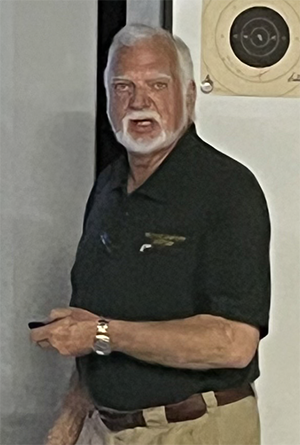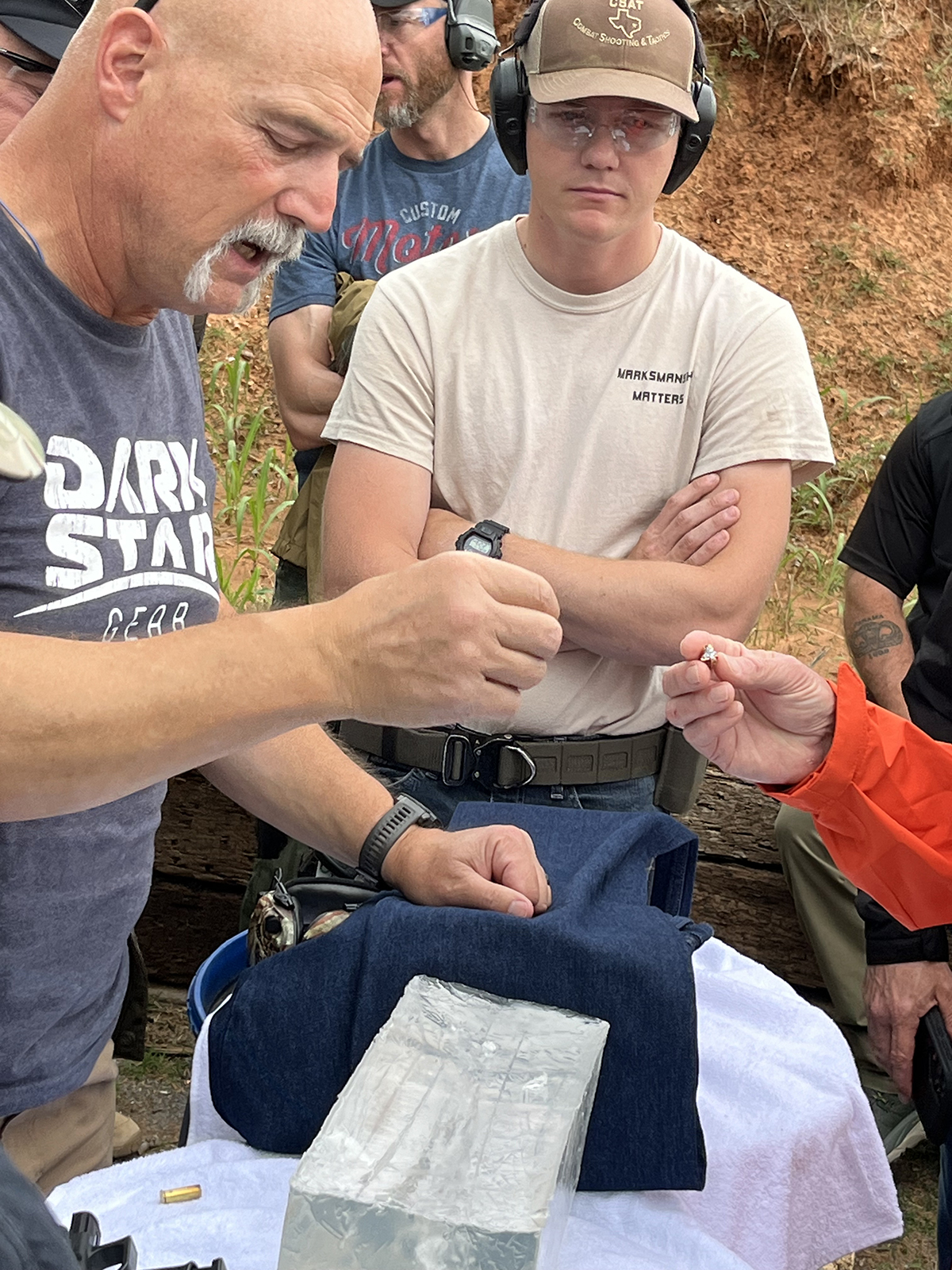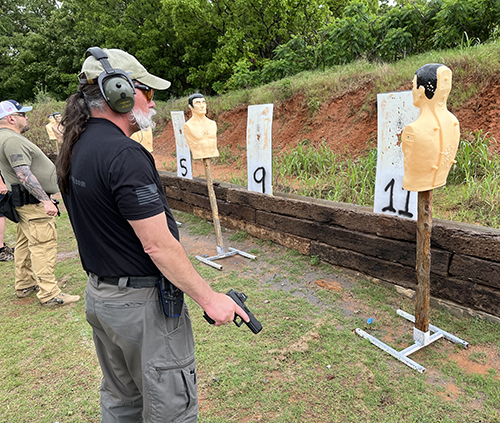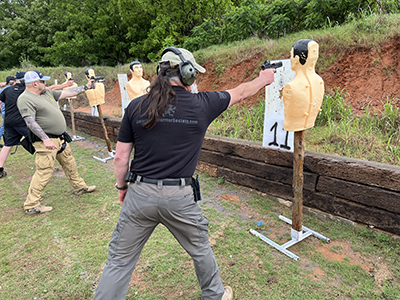Last November, I attended the Pat Rogers Memorial Revolver Round-Up held at Gunsite Academy, and one of the multitude of training sessions offered was a two-hour block of instruction taught by an emergency room physician, Dr. James Williams.
 You have probably heard the term “tactical anatomy.” The phrase is the creation of Dr. Williams to describe his philosophy of using firearms to instantly stop a murderer who is in the middle of attempting to kill someone. For several years I had heard the phrase and had hoped one day to learn more about his teachings. While attending his brief seminar at the Round-Up, I learned that he was teaching a two-day instructor certification course in May of 2024 in Oklahoma. I instantly signed up for the Shooting with X-Ray Vision Instructor Certification Course, and I am glad that I did. This article details the contents of the course, and expands upon the philosophy of Dr. Williams’ teachings.
You have probably heard the term “tactical anatomy.” The phrase is the creation of Dr. Williams to describe his philosophy of using firearms to instantly stop a murderer who is in the middle of attempting to kill someone. For several years I had heard the phrase and had hoped one day to learn more about his teachings. While attending his brief seminar at the Round-Up, I learned that he was teaching a two-day instructor certification course in May of 2024 in Oklahoma. I instantly signed up for the Shooting with X-Ray Vision Instructor Certification Course, and I am glad that I did. This article details the contents of the course, and expands upon the philosophy of Dr. Williams’ teachings.
Of course, when considering a specific training course, there are several reasons one should research the background of the instructor. The first reason is to give you confidence that the instructor is well-versed in the field he is teaching. As I did my due diligence, I learned that Dr. Williams’ background is very similar to my own. First, one of his mentors in the discipline is none other than Massad Ayoob. “Doc” Williams is a Massad Ayoob Group Staff Instructor, as am I. Knowing the effort that entails gave him instant credibility in my eyes. He also had a background as a competition shooter, winning championships in IDPA a decade or two ago. This, to me, means he had performed at a high level under stress and came away victorious. While this was not a shooting course, if it had been, the students would have been in good hands.
Lastly, Dr. Williams’ education, training and experience as an emergency room doctor instantly gives him the “chops” to talk about what bullets do to people, and how the armed citizen can increase the odds that the outcome of an armed encounter will see the armed citizen shooting to save his life or the life of another innocent. As Williams is now in the autumn of his career both as an instructor and a doctor, by teaching and certifying others in this discipline, he is ensuring that his teachings will survive beyond his own first-hand involvement.
What Did I Learn?
The Shooting with X-Ray Vision Instructor Certification Course did not lack in content, that is for sure. This course consisted of classroom lecture using a vibrant PowerPoint presentation, which included shooting recipient photos presented to illustrate points Dr. Williams wanted to make regarding bullet effectiveness. Also discussed in classroom lecture was instructional doctrine and how to communicate this information along with, of course, plenty of Q & A sessions. Before I go on, I should mention the lavish classroom facilities of the Mead Hall Training Facility, located just outside of Oklahoma City, in the rural community of McLoud, OK. Owner Bill Armstrong has spared no expense to create one of the best training ranges in the country, and each year he hosts several of the most well-respected trainers in the nation.
The classroom part of Dr. Williams’ two-day course included several practical exercises, one of which saw the students donning white t-shirts and drawing the major organs and vessels of the human body on a fellow student with a felt-tip pen. The point of this exercise was to involve the students in a hands-on exercise, to prepare them to visualize the points of aim on the human body for which the defender/shooter should aim. It may sound simple, but those aiming points depend on the angle and how much of their body the attacker presents to the shooter. The bullet placement goal is not simply the “center of mass” or even the chest, brain, and pelvis, but the individual parts of those organs and bone masses.
Why Is This Important?
The history of gunfighting is filled with reports of people who, having been shot, continued to attack, and went on to kill others. The goal of defensive shooting is to immediately incapacitate the killer – to stop the action. Unfortunately, the trend in defensive handgun training is to put as many bullets on target as rapidly as possible, expecting the aggregate of bullet wounds to stop the attacker. While that outcome is certainly likely, it is not foolproof. The human body can live and return fire despite multiple gunshot wounds, as long as the gunshots do not shut down the central nervous system or immediately reduce blood flow to the brain. In this course, Dr. Williams teaches where to put the bullet or bullets to increase the odds in your favor.
The other reason this is important is that the fewer bullets the good guy fires, the less likelihood he or she will miss the target and strike a bystander or hostage. Students watched a video of an incident in which a police officer, when facing a man who had taken a baby hostage, quickly aggressed upon the hostage taker and shot him in the deep brain. Sometimes it is necessary to close the distance and fire instead of seeking cover and negotiating.
Additionally, I view all training conducted through what I believe are the eyes of a prosecuting attorney. I ask, “Is there any material being presented that would come back to haunt the students in court?” I have seen a lot of training presented in my lifetime that might just be a problem, especially if the student followed the instructor’s teaching. Fortunately, this class was not one of those, which pleased me.
One last thought about the training Dr. Williams presented: we instructors need to be teaching more of this type of shooting. We need to teach pin-point accuracy under stress, with less emphasis on two-tenths of a second splits. (A split is the time between shots in a multiple shot string of fire, for which .2 seconds is considered good.) It is too easy to put shots in a person’s back as they twist and fall from the effect of the first shots, and if there is one thing that gets people prosecuted, it is the shot in the back.
During the second day of training, the class was treated to a ballistic gelatin shoot, managed by renown instructor Chuck Haggard. Wound ballistics was a large part of the classroom lecture, to assure that students understood that bullet penetration – but not too much penetration – is paramount in good wound dynamics. The bullet must penetrate deeply enough in the body from all angles to hit the intended targets, and with enough force to do significant damage.
Additional tactical exercises saw the class participating in video simulators designed to have the student make shooting decisions about shot placement in keeping with the theme of the doctrine, after which we went to the live fire training range, where we replicated the incident I mentioned earlier, in which a police officer saved a baby that was taken hostage. The class also shot three-dimensional mannequin targets, from different distances and angles, using our newly developed x-ray vision.
In summary, it was a pleasure to study for two days with a group of professionals, starting with “Doc” Williams, host Bill Armstrong, and Instructors David Maglio, Chuck Haggard, and Dr. Troy Miller, along with the student group who were all advanced-level professionals in their own right.  The Shooting with X-Ray Vision Instructor Certification Course was what I would expect in high-level instructor training. If you want to make the class next May contact Dr. Williams through his website https://tacticalanatomy.com/ . When I checked just prior to article publication, the class was not listed yet, but an e-mail to Dr. Williams should get you on the notification list.
The Shooting with X-Ray Vision Instructor Certification Course was what I would expect in high-level instructor training. If you want to make the class next May contact Dr. Williams through his website https://tacticalanatomy.com/ . When I checked just prior to article publication, the class was not listed yet, but an e-mail to Dr. Williams should get you on the notification list.
__________
Marty Hayes, J.D. is president and a founder of Armed Citizens’ Legal Defense Network. He brings 30 years experience as a professional firearms instructor, 30 years of law enforcement association and his knowledge of the legal profession both as an expert witness and his legal education to the leadership of the Network.
